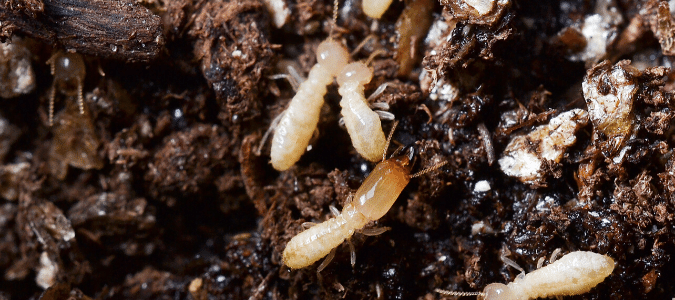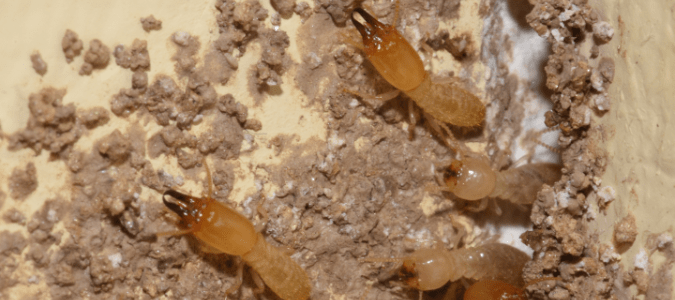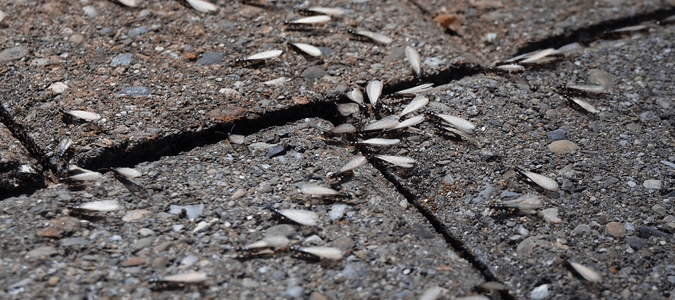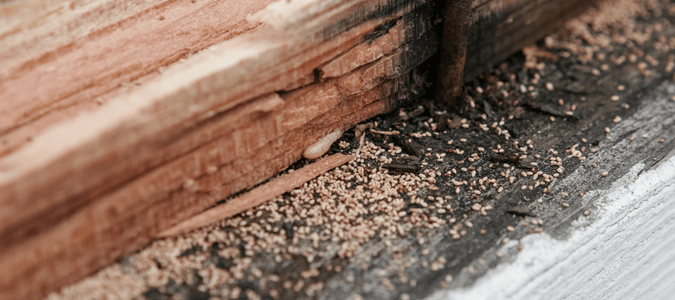Do you know the difference between subterranean termites versus drywood termites? These termite species have several similarities in their appearance and behavior, but there are also key differences that can help you tell them apart.
Identifying which type of termite is infesting your home is the first step in controlling the termite colony. The most important thing to remember is that all types of termites can cause severe structural damage to your home and need to be dealt with quickly.
Not all termites fly, but each species has a type of termite that has wings. They are called swarmer termites, and it is their job to fly away from their current colony to reproduce and form new colonies. These termites discard their wings after mating, and homeowners often spot them around their houses. Discarded termite wings are a sure sign that a mature termite colony is nearby.
It’s important to take the right steps to control a termite colony as soon as you discover them. These unwelcome pests can cause severe damage to your home and property, and lower your home’s property value. Do not try to eradicate termites on your own. A professional pest control service will get rid of the entire colony.
Subterranean Termites Versus Drywood Termites
Subterranean termites and drywood termites have several similarities in their behavior and appearance. However, there are also major differences in how they infest homes, grow their colonies and cause damage.
Everything You Need to Know About Subterranean Termites
As their name suggests, subterranean termites prefer to live in underground habitats. If they don’t find somewhere to grow their colony underground, they look for aboveground areas that are moist and well hidden, such as damp wood piles.
These unwelcome pests can grow large colonies quickly, which is why it’s important to catch an infestation early. They live in colonies with up to one million in population. Subterranean termites require moisture, so they build mud tubes to travel through.
Subterranean termites’ appearance differs on the type of termite in the colony. There are worker termites, soldier termites and swarmer termites. Each class can range in color from pale cream to dark brown to black.
Worker termites are the ones that chew through your home’s structure. They can be one-eighth to three-eighths of an inch long and are typically white or cream-colored. Their bodies are long and narrow and they have two antennae.
Soldier termites look similar to worker termites but have large mandibles attached to their brown heads. Their role is to defend the colonies against attacks, so they ram their heads into the wood to alert the worker termites of a threat. Soldier termites only make up a small portion of a subterranean termite colony.
Lastly, swarmer termites are the ones that reproduce. Unlike the other classes, they have wings so that they can fly away from the colony to mate and form new colonies. After mating, they discard their translucent wings and it’s common for homeowners to see them by their doors, floors and windowsills.
Swarmer termites typically swarm in the spring. If you see them or their wings in your home, it is a sign that a subterranean termite colony is nearby. Do not hesitate to contact a pest control service to control the colony before they cause severe structural damage to your home.
Everything You Need to Know About Drywood Termites
Unlike subterranean termites, drywood termites do not nest underground. They build their colonies in wood and enter your home by air instead of mud tubes. Since they don’t need moisture like subterranean termites, they do not need mud tubes to keep them hydrated, and they do need contact with the soil.
Drywood termites can be larger than subterranean termites. Their bodies range from one-fourth of an inch to one inch long, and they are more oval in shape. Like subterranean termites, they have six small legs and two straight antennae. Their bodies can be cream-colored, light brown, dark brown or black.
Drywood termite colonies are much smaller than subterranean colonies and only grow to about 2,500 members. Their caste system is also different from subterranean termite colonies. Instead of having a working class, young termites do the work until they reach maturity.
Termites infest your home and cause damage from the inside out. If you think you have drywood termites in your home, call a professional pest control service right away.
Can Termites Fly?
Some types of termites have wings and can fly. They are the swarmer termites and they are present in all termite colonies. The swarmer termites are the only termites that reproduce. When a colony is full, they leave the nest to find a mate and start a new colony. The new colony may be near the old colony, such as in the same house.
However, swarmer termites may also try to leave your house through your doors, windows and cracks. Swarmer termites swarm throughout the year depending on their breed and where they live. They only swarm once and discard their wings after mating so they can settle into their new colony. Most homeowners find swarmer termite wings before they realize that there is an infestation in their home.
Swarmer termite wings are translucent and double the size of the termite body. They have two sets of wings that are the same exact length, making it hard to tell them apart. Swarmer termites are often confused with flying ants. However, flying ants have two sets of wings that are different lengths.
If you see discarded insect wings in your home or dead termites on your windowsill, there has likely been a termite swarm. That means that a full termite colony is nearby and could possibly be doing severe damage to your home’s structure. Call a professional pest control service right away to control the termite colony.
What to Do if You Have Termites
Since termites live inside your home, it is hard to reach the colony on your own. The best way to completely get rid of a termite population is to enlist professional help.
Termites can do more damage to your home than you might suspect or see. Along with chewing through the wood in your walls, ceiling, attic and basement, they can also damage your drywall. These pests are even able to chew through plaster and insulation. Your foundation, support beams and columns are also at risk when you have a termite infestation.
If a colony gets big enough, you may even find termites in your furniture. Since termites chew through the wood from the inside out, you can tell if you have an infestation by knocking on the wood. If you hear a hollow sound, there might be termites inside.
Termites can also cause damage on the outside of your property. Some types of termites like to live in wood piles. If you have firewood piled up on the side of your house, it becomes an easy way for termites to enter your home.
If you suspect that a termite colony has taken up residence in your home or on your property, contact a pest control specialist to inspect your home right away. Do not try to control the colony on your own. Termites live in large colonies, so it is important to get rid of the colony thoroughly.
Regular home inspections are one way to catch a termite infestation early. Keeping loose wood away from your home’s exterior, only using a light layer of mulch in your garden beds and keeping your lawn tidy are other ways to deter these pests.
Get Rid of Subterranean and Drywood Termites
No matter whether you have subterranean, drywood or another type of termite, it’s important to get rid of the infestation as quickly as possible. Each type of termite can cause severe damage that will become costly.
Remember that the major difference between subterranean and drywood termites is in their behavior and habitat preferences. You may see both types in your home.
The first way that most homeowners discover a termite infestation is by seeing the discarded wings of swarmer termites. It’s important to remember that some types of termites can fly and point you to a larger termite colony in your home.
Finally, contact a professional pest control service as soon as you see or suspect a termite infestation in your home. You do not want to wait and let them cause more damage. An expert can thoroughly treat the colony and keep your home safe.
ABC Can Get Rid of Termites
Termites are a major threat to the structural integrity and safety of your home. If you see termites or the signs of an infestation, contact a pest control specialist right away. The experienced technicians at ABC Home & Commercial Services know exactly where these pests like to hide. Our termite experts can create a customized treatment plan for your home that incorporates scientifically proven treatments that can eliminate the entire colony of termites. In addition, we offer an ongoing termite monitoring program that can put your mind at ease and help you avoid any future problems.




